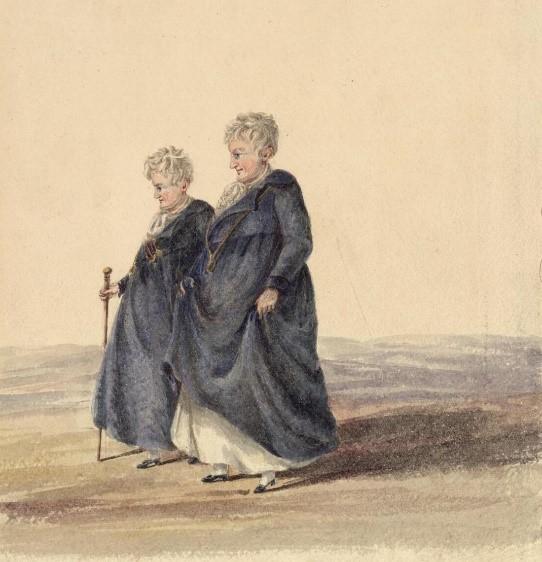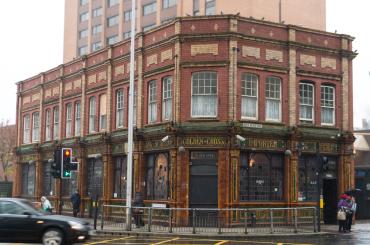The Ladies of Llangollen
Today, Plas Newydd in Denbighshire is a Grade II* Listed Building, open to the public, and operated by Denbighshire County Council.
But it wasn’t always that grand – it began life as a small cottage with three windows, until it was acquired by Eleanor Butler and Sarah Ponsonby. These ‘Ladies of Llangollen’ were independent women, history buffs and, quite possibly, the 18th century’s first lesbian power couple!
Eleanor Butler (1739-1829) and Sarah Ponsonby (1755-1831) met in 1768 when Sarah was a teenager and Eleanor was in her late twenties. Both were members of wealthy families from the Irish aristocracy and both were determined not to be married off, the usual fate for women of their social station at the time.
They were so committed to their freedom that 10 years later they attempted to flee the country together, disguised as men. The escape was thwarted by their families but – after some discussion – the two women were allowed to leave Ireland for Wales. There, they travelled around for a while before settling down and ‘retiring’ in Llangollen in 1780 (now aged 25 and 41), where they would live as a couple for nearly fifty years with their servant Mary Carryl and a series of dogs named Sappho.
Relationship questions
As respected members of the upper-class, the question of the Ladies’ sexuality was not up for open discussion. They were sometimes praised for choosing lives of ‘virginity’ and the idea that they had a sexual relationship may just not have occurred to many of their visitors. The Ladies threatened legal action against one newspaper for describing their ‘extraordinary female affection’ in unflattering terms – also suggesting Eleanor dressed as a man and was the ‘masculine’ half of the couple.
Confirmed lesbians of their generation were naturally fascinated by them. They inspired works by the Romantic poet Anna Seward (1742-1809), who was openly envious of their lifestyle. The diarist Anne Lister (1791-1840) – sometimes described as the first modern lesbian – visited Llangollen and met Sarah Ponsonby. In a letter to her lover Mariana Lawton, she wrote that she thought it was unlikely that the Ladies of Llangollen’s relationship was ‘platonic’.
Independent women
Despite their dramatic rejection of marriage, the Ladies were able to stay on surprisingly good terms with their families. Llangollen’s position on the main transport route between Ireland and London meant they often received visits from relatives – as well as other members of the Anglo-Irish aristocracy. There was widespread curiosity about their life together and many admired them for choosing to live happily in relatively modest circumstances, as opposed to a grand Irish castle.
As members of the aristocracy, the Ladies never worked, relying on gifts from relatives and friends to maintain their lifestyle. Entertaining rich guests and curating their celebrity became a career for them. They built up a reputation as excellent hosts and conversationalists, welcoming many distinguished visitors – including the Duke of Wellington, Lord Byron and a young Charles Darwin. On the advice of Queen Charlotte, the Ladies were eventually granted a royal pension by King George III, finally giving them financial security.
Plas Newydd
When they moved in, their house was a small cottage with three windows named Pen-y-maes on the Afon Cyflymen. However, the Ladies had big plans for the place. They renamed it Plas Newydd (the New Palace in Welsh) and made huge changes over many years, adding a library and servants’ quarters – as well as employing a gardener and acquiring neighbouring plots of lands to develop fine gardens around their home.
The very well-read couple also indulged their passion for history by building a huge collection of antique oak carvings – many rescued from medieval churches – which they incorporated into the fabric of their home. In the gardens, they made features out of medieval church fonts and part of the city of Chester’s medieval High Cross, which had been torn down during the English Civil War.
A lasting legacy
Eleanor and Sarah died within a couple of years of each other and are buried together in the graveyard of St Collen’s Church in Llangollen – alongside their Irish servant Mary Carryl who had died twenty years earlier. A memorial to all three women still stands in the churchyard and the carefully preserved house and gardens at Plas Newydd survive as a testament to the Ladies’ success in defying the conventions of their time.
While we may never know whether they were lesbians or not, there is no denying that they were a source of inspiration to women who were. Their long life together provided a powerful demonstration that two women could build a stable and happy home, paving the way for a more open and tolerant future.

